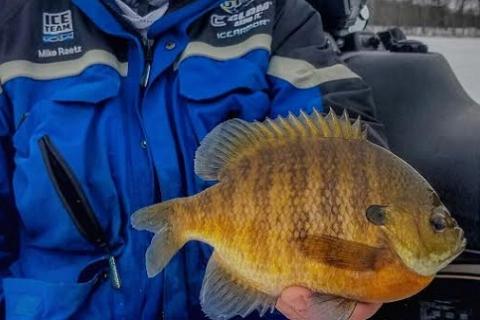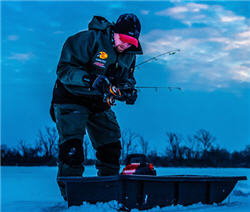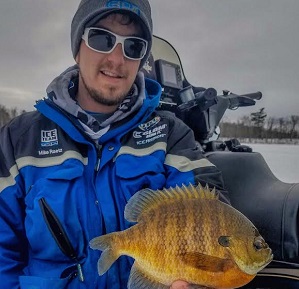
by Tayler Michels (Staff Writer for Jason Mitchell Outdoors)
 Today’s modern era of ice fishing offers advancements in equipment that make anglers more efficient on the ice. Flashers, underwater cameras and GPS Mapping have helped us locate and catch a lot more fish. Besides equipment that can help us find and react to fish, other new developments to ice fishing include more efficient presentations. Both tungsten jigs and soft plastic baits have become extremely popular with anglers targeting panfish and bluegills in particular.
Today’s modern era of ice fishing offers advancements in equipment that make anglers more efficient on the ice. Flashers, underwater cameras and GPS Mapping have helped us locate and catch a lot more fish. Besides equipment that can help us find and react to fish, other new developments to ice fishing include more efficient presentations. Both tungsten jigs and soft plastic baits have become extremely popular with anglers targeting panfish and bluegills in particular.
Big bluegills are a coveted prize for ice anglers. The key to catching big bluegills is to fish where they live but many ice anglers will agree that there can be an art to effectively catching the biggest bulls with soft plastics. For this article, we pick the brains of a couple of fanatical ice anglers who love to target really big bluegills and their insights are spot on.
Ice Fishing Legend Dave Genze
“Match the Hatch when dialing in bluegill,"explains ice fishing legend Dave Genz. “When it comes to soft plastics, you’re always trying to mimic something that really exists in the food chain, a bug like a water beetle or back swimmer, perhaps a blood worm or midge larvae, even fresh water shrimp. Big bluegills are very aware of their environment and to put something down there that is foreign to the ecosystem usually won’t get the desired reaction. Soft sticky bottom basins often have blood worms for example and you typically expect a long skinny worm shaped plastic in various dark colors to get bit. Pound the bottom to stir up some mud and slowly raise your jig mimicking a blood worm.”
 Underwater insects and fresh water shrimp often use legs for propulsion through the water so the basic action on many soft plastics is a quiver where the bait hovers in place while the legs or tentacles dance in place creating a powerful trigger for fish. One of the greatest soft plastics of all time for winter panfish gurus is the classic Makki which has several tentacles and can be fished to resemble many different invertebrates like caddis fly larvae or a wiggler. Typically, insects slowly kick up or away so this quivering combined with a slow raise or pause looks natural to big bluegills that have spent a lifetime eating bugs.
Underwater insects and fresh water shrimp often use legs for propulsion through the water so the basic action on many soft plastics is a quiver where the bait hovers in place while the legs or tentacles dance in place creating a powerful trigger for fish. One of the greatest soft plastics of all time for winter panfish gurus is the classic Makki which has several tentacles and can be fished to resemble many different invertebrates like caddis fly larvae or a wiggler. Typically, insects slowly kick up or away so this quivering combined with a slow raise or pause looks natural to big bluegills that have spent a lifetime eating bugs.
Ice Junky Angler Mike Raetz
Mike Raetz from Clam Corporation is a hardworking ice junky who is obsessed with big bluegills. Raetz fishes heavily pressured lakes in central Minnesota near Minneapolis and his strategy is straightforward, "start small and simple." Raetz starts with natural colors that depend on water clarity, "I like to use black in dark water where as I will lighten up to colors like motor oil in more clear water.”
Raetz likes to start out with smaller bait presentation to help feel out the bite. Get bit first and than figure out how to get the bigger fish. If the bite is hot, upsizing can be the key to finding the big sunfish in a pack where you can separate the fish. There are other situations where larger profiles will lift the bigger bluegill out of a school where you have to fish above the pack. Other days call for much more subtleness and finesse where the small fish rush in where as the big bluegills hang back from the bait and scrutinize.
Raetz stresses that with such a wide variety of soft plastics on the market today, don’t be overwhelmed and feel like you need to own them all to catch fish. An advantages of plastic baits is that they are plastic, which means they can be modified, adjusted or placed on the hook multiple ways making one bait seem like four. During a lighter bite, Mike will downsize to get bit and when the plastics don’t get any smaller he will even tear off a single tentacle to trigger bites. Being able to modify and make adjustments shows just how versatile these baits really are.
Plastic Baits - The Action is the Attraction
With soft plastics, anglers can experiment with vibration, profile and color. The action is the attraction and from an action perspective, hand poured plastic baits are head and shoulders above the rest in terms of achieving the desired lifelike motions. Both Dave Genz and Mike Raetz have had a heavy input on the Makki Plastic designs. These hand poured soft baits are more pliable and deliver the best performance.
Building confidence in a new bait can be a challenge for any angler, particularly for anglers who have used wax worms their entire life. To be clear, soft plastics shouldn't entirely replace live bait but compliment live bait. Because of the triggering qualities and durability, soft plastics add a lot of arrows to your quiver but you have to believe in the effectiveness.
Mike Raetz adds without hesitation “Build confidence... If anglers can gain the confidence, the results will speak for themselves. Find a hot bite and learn the nuances and quivers that trigger fish to speed up the learning curve. Raetz's confidence bait is the Clam Pro Tackle Half Ant tungsten jig matched with a Makki Polli rigged so that the Polli is horizontal. Dave Genz prefers his own signature Clam Pro Tackle Drop-Kick jig matched with a tentacled plastic such as the original Makki. Genz describes, “slide the plastic on the hook part ways so the tentacles are pointed up, this will mimic an invertebrate swimming back down to the bottom. A quiver motion will make that hand poured plastic come alive.”
“Early ice and mid winter I use similar presentations but for different reasons” Raetz explains. "Early ice I’m usually dealing with skittish fish in shallow water below thin ice where I find smaller and subtler baits work well. Typically on metro lakes, I have to modify and manipulate the presentation constantly to trigger a big bite. Mid winter can create challenges during the frigid cold fronts where I am dealing with lethargic fish that don’t always want to bite. Again... I’m using smaller vertical jigs and downsized plastics, trying to perfect that gentle quiver action.” Mike adds, “Then on late ice I have more confidence to go with the upsized plastics on a horizontal jig where I am going to be more aggressive with my jigging action."
Tougher bites will require anglers to use one to two pound monofilament line. On a better bite, anglers can often get away with four pound test if using tungsten jigs because tungsten fishes so much heavier than traditional lead. Catching big bluegills today is all about reading the conditions and adjusting to the situation. Soft plastics allow today's ice anglers to refine and adapt to a wider range of circumstances which increases efficiency that leads to more fish. More fish leads to bigger fish and that is the key to catching some of the biggest bluegills each winter.
- 4933 views

